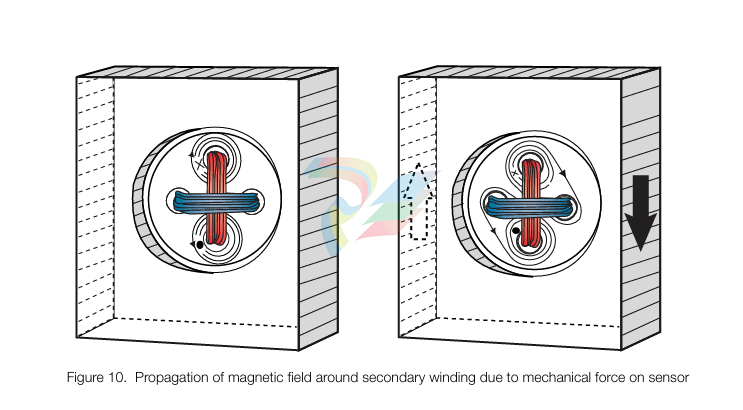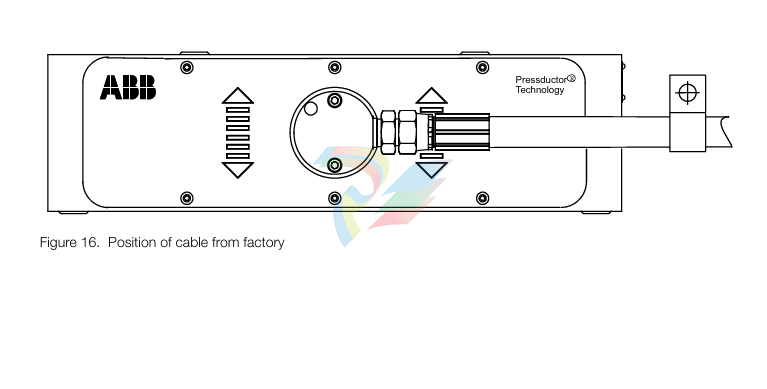- EMERSON
- Abaco
- Kongsberg
- Pacific Scientific
- AMAT
- ICS Triplex
- Lam Research
- KUKA
- Hirschmann
- ELAU
- EATON
- Applicom
- Watlow Anafaze
- Meggitt Vibro-meter
- Carrier
- Other
- ROCKWELL
- Rolls-Royce
- SAACKE
- Yokogawa
- B&R
- Reliance Electric
- Seifert
- A-B
- Weimeide Metso
- KEBA
- HIMatrix
- Valmet
- Schneider
- Prosoft
- PEPPERL+FUCHS
- Honeywell
- Woodward
- GE
- GEA Westfalia Separator
- Bently Nevada
- ALSTOM
- Foxboro
- MOTOROLA
- Fanuc
- VMIC
- KOLLMORGEN
- SEW
- Rexroth
- AEROTECH
- TOSHIBA
- TmeIC
- Sumitomo
- SOCAPEL SOCASIN
- SMC
- Stromag
- SIEMENS
- SCHUMACHER
- ABB
- MOOG
- EPRO
- EMERSON
- Triconex
ABB PFCL201CE 50KN 3BSX802939-108 sensor
Measuring principle of the sensor
The measuring principle of the sensor is based on the Pressductor® technology and the fact that the permeability of a magnetic material changes under mechanical stress.
The sensor is a membrane machined in the load cell. Primary and secondary windings are wound through four holes in the load cell so that they cross at right angles.
The primary winding is supplied with an alternating current which creates a magnetic field around the primary winding. Since the two windings are at right angles to each other, there will be no mag netic field around the secondary winding, as long as there is no load on the sensor.
When the sensor is subjected to a mechanical force in the direction of measurement, the propaga tion of the magnetic field changes so that it surrounds the secondary winding, inducing an alternat ing voltage in that winding.
The control unit converts this alternating voltage into a DC voltage proportional to the applied force. If the measurement force changes direction, the sensor signal changes also polarity.

Mounting Arrangement
When choosing a mounting arrangement it is important to remember to position the load cell in a
direction that gives sufficient measuring force (FR) to achieve the highest possible accuracy.
The load cell has no particular correct orientation; it is positioned in the orientation best suited for
the application, bearing in mind the positions of the screw holes. The load cell can also be installed
with the roll suspended under the load cell.
The load cell has the same sensitivity in both tension and compression, so the load cell can be
installed in the easiest manner.
Typical mounting arrangements are horizontal and inclined mounting.
Coordinate System
A coordinate system is defined for the load cell. This is used in force calculations to derive force
components in the load cell principal directions.

Where direction designations R, V and A are recognized as suffixes for force components, F, this represents the force component in the respective direction. The suffix R may be omitted, when measuring direction is implied by the context.
Horizontal Mounting In the majority of cases horizontal mounting is the most obvious and simplest solution. Stand, mounting surface and shims (if required) are simple and cheap to make. When calculating the force, the equations below must be used: FR = T × (sin α + sin β) FRT = Tare FRtot = FR + FRT = T × (sin α + sin β) + Tare FV = T × (cos β - cos α) FVT = 0 FVtot = FV + FVT = T × (cos β - cos α) + 0 = T × (cos β - cos α) where: T = Strip tension FR = Force component from strip tension in measurement direction, R FRT = Force component from Tare in measurement direction, R FRtot = Total force in measurement direction, R FV = Force component from strip tension in transverse direction, V FVT = Force component from Tare in transverse direction, V FVtot = Total force in transverse direction, V Tare = Force due to tare weight α = Deflection angle on one side of the roll relative the horizontal plane β = Deflection angle on the other side of the roll relative the horizontal plane
Inclined Mounting
Inclined mounting means arrangements in which the load cell is inclined relative to the horizontal
plane. In some cases this is the only option.
When calculating the force, the equations below must be used:
FR = T × [sin (α - γ) + sin (β + γ)] FRT = Tare × cos γ FRtot = FR + FRT = T × [sin (α - γ) + sin (β + γ)] + Tare × cos γ FV = T × [cos (β + γ) - cos (α - γ)] FVT = - Tare × sin γ FVtot = FV + FVT = T × [cos (β + γ) - cos (α - γ)] - Tare × sin γ γ = 90° - φ where: T = Strip tension FR = Force component from strip tension in measurement direction, R FRT = Force component from Tare in measurement direction, R FRtot = Total force in measurement direction, R FV = Force component from strip tension in transverse direction, V FVT = Force component from Tare in transverse direction, V FVtot = Total force in transverse direction, V Tare = Force due to tare weight α = Deflection angle on one side of the roll relative the horizontal plane β = Deflection angle on the other side of the roll relative the horizontal plane φ= Angle for measurement direction relative the horizontal plane γ = Angle for load cell mounting surface relative the horizontal plane
The Electrical Circuit
The electrical circuit of the load cell is shown in the diagram below.
The load cell is supplied with a 0.5 A, 330 Hz alternating current. The secondary signal is calibrated for the correct sensitivity with a voltage divider R1 - R2, and temperature compensation is provided by thermistors T.
All impedances on the secondary side are relatively low. The output impedance is typically 9-12 Ω , which helps to suppress interference.

ABB UDC920BE01 3BHE034863R0001
ABB XUD194 XUD194A 3BHC018137R0001
ABB PPD513AOC-100440 3BHE039724R0C3D 800 D513
ABB 5SHY4045L0001 3BHB018162 3BHE009681R0101 GVC750BE101
ABB 3BHE039724R0C3D PPD513 A0C-100440 AC800PEC
ABB DKTFM418B 3BHB015651P0001
ABB G2000A5.7ST
ABB 3BHE017628R0002 PPD115A02 SG579989013
ABB REM615 HBMBCCAHNBA1ANN1XD
ABB LS4000
ABB PM864AK01 3BSE01816R1
ABB PFTL101B 3BSE004185R1 2.0KN
ABB PFCL201CE 50KN 3BSX802939-108
| User name | Member Level | Quantity | Specification | Purchase Date |
|---|


-
EMERSON M-series Intrinsically Safe I/O
-
Configuration for AMS 6500 Protection Monitors
-
EMERSON DeltaV™ M-series Traditional I/O
-
EMERSON DeltaV™ SQ Controller
-
AEROTECH Ndrive MP Hardware Manual
-
AEROTECH Ndrive HPe 10/20/30
-
AEROTECH Ndrive CP Hardware Manual
-
AEROTECH Ndrive Linear Series Digital Servo Amplifiers – Linear
-
AEROTECH Ndrive HP 10/20/30 P/N: EDU170
-
AEROTECH EDU176_Ndrive_HL
-
ADVANCEDMOTION CONTROLS Analog Servo Drive 120A10
-
GE JPAX-H
-
GE JPAX family
-
GE Industry Leading Experience
-
GE Ether-1000 Unit
-
GE Cyber Secured Service Unit
-
GE Lentronics E1MXe Multiplexer
-
GE TTMX Teleprotection Terminal
-
GE Lentronics T1 Multiplexer
-
GE Lentronics JungleMUX SONET Multiplexer
-
GE Lentronics E1MX Multiplexer
-
GE Lentronics TN1Ue SDH Multiplexer
-
GE Lentronics TN1U SDH Multiplexer
-
GE Gridcom DXC Family Access and Transmission Multiplexer
-
GE Advanced Network Management
-
GE Lentronics VistaNET Network Management System (NMS)
-
ABB System Controller Connect
-
Ethernet Module EI 803F ABB
-
ABB Ethernet Modules EI 802F
-
ABB Ethernet Modules EI 801F
-
ABB Power Supply SD 802F / SD 812F
-
ABB Power Supply SA 801F / SA 811F
-
ABB Basic Unit PM 802F /PM 803F
-
Control product - Soft starter PST/PSTB (Intelligent Type) ABB
-
ABB CP450 Installation and Operation Manual
-
ABB ompact 800 5.1 Product Catalog
-
ABB Panel 800 version 6
-
ABB Panel 800 Version 6- Panel Builder Version 6.0-1
-
ABB Control Panels CP405 Control Panels CP408
-
ABB PowerUP for medium voltage drives
-
GE MiCOM P40U Connect MiCOM P40 IEDs to PCs with USB ports
-
Reason RT431 GPS Precision-Time Clock GE
-
GE Reason RT430 GNSS Precision-Time Clocks
-
GE Reason H49 PRP/HSR Redbox Switch
-
GE Reason S20 Managed Ethernet Switches
-
GE Gridcom DIP.net
-
Central Control Station at Jaenschwalde mineLausitzer Braunkohle AG, Germany 2000
-
ABB Ability™ System 800xA Advant® Master S400 I/O to S800 I/O Evolution
-
ABB with Advant Controller 400 series
-
Advant™Automation with MOD 300™ Software
-
Bently 2300/20 and 2300/25 2300 Vibration Monitors
-
ABB NGC8206 Natural Gas Chromatograph Dual Unit
-
MOTOROLA MVME2400 TM VME Processor Modules
-
5320 Series Foxboro DCS Control Network Ethernet Equipment
-
ExtremeSwitching™ 5420 Series
-
WOODWARD EGCP-3 Engine Generator Control Package LS (Load Sharing)
-
5520 Series Universal Edge/Aggregation-Switch Platform
-
X440-G2 Series
-
EMERSON FloBoss™ S600 Flow Manager Specification Sheet
-
KONGSBERG RAIV400 Remote Analogue Input, Voltage
-
RMP420-Remote Multipurpose Input/Output Kongsberg
-
610 serie ABB Feeder Protection REF610 Product Guide
-
Triconex 3351S2 Controller Features
-
HBRF Megamax – Emax2 Air Circuit Breaker ABB
-
ABB MEASUREMENT & ANALYTICS | DATA SHEET LS4000 Diode laser analyzer
-
Pressductor Pillowblock Load Cells Vertical Measuring PFCL 201 User manual
-
PARKER BFR5K Series
-
AC 900F controller ABB
-
Uniop ePAD05 and ePAD06 Technical description
-
Hitachi ABB Communication Unit 560CMR02
-
MOTOROLA MVME5500 Series VME Single-Board Computer
-
ABB Symphony Plus SD Series HPC800 controller
-
ABB AC800M Controller Hardware System
-
ABB AC800M PROFIBUS DP Installation System
-
ABB Freelance 800F AC800F Control systems
-
ABB Compact control system replaces PLC AC700F
-
abb Triguard SC300E 3BNP004720R101 TMR Safety Products
-
ABB Distributed busbar protection REB500
-
ABB Advant Controller 400 series
-
ABB MEASUREMENT & ANALYTICS | PRODUCT GUIDE
-
PACIFIC SCIENTIFIC PC800 PC832 PC830 Series Digital Brushless Servo Drive
-
PSS41S-3FDCTSAA Triconex DCS System Access Application Driver for Field Device Controller 280
-
Alstom controller of ICP232 029.359325
-
DEIF DU-2/MKIII Paralleling And Protection Unit General information
-
ABB 3ADT220134R0001 SDCS-COM-81 board 10MBd
-
ABB 3BHB006338R0002 UNS 0881a-P,V2:GDI PCB assembled *PB
-
ABB GRID BREAKER UNIT GBU72 3BHE055094R0002 / 3BHE031197R0001 / 3BHB030310R0001
-
ABB PCS6000 PRODUCT FAMLIY
-
ALSTOM SPU232.2 controller UNIT 029.366 817 029366817 SPU2322
-
ABB AO2000-LS25 Operator’s Manual 41/24-109 EN Rev. 3
-
Alstom EPSD-0603 series Circuit board redundancy architecture
-
ABB GJR2390200R1411 83SR04R1411 Control Module Universal
-
GE Digital Energy Hydran 201Ti Mark IV Essential DGA monitoring
-
Bender ISOMETER®IRDH275 IRDH275B
-
ABB 3BSE017235R1 PXAH 401 Operator Unit
-
HIMax-TECHNICALFACTS
-
Power supply CP-E 24/1.25 ABB
-
ABB NSIN0070-5 (IP23) 3ABD00024914
-
ABB 1VCR000993G0002 PCB card
-
ABB 2CSG524000R2021 TMD-T4/96 Temperature control unit
-
3BHE014135R0011 UAD149A0011 ABB AC800PEC series
-
Alstom CT94360/01 signal regulator
-
MISP2-2W-T00-1000 GE Measurement & Control Solutions
-
DEIF AGC150 independent generator controller
-
DEIF AGC-4 10102264.10 Advanced generator set controller
-
ABB Plantguard Communications P8151B P8110B
-
ABB Plantguard series P8403 Digital input module
-
ABB 3BHE041343R0102 PCD530A102 Comm. Contr. & Meas. (CCM)
-
ABB P8431 TMR analog input module
-
ABB P129740-002 SIO Assembly,Smart Weight,Interface,Pre-
-
3BHB007441P0001 LDSTA-01 ABB inverter control CPU driver board
-
ABB LD series LDMTR-01 63940135F I/O module
-
ABB 7525A38G01 SCV-MR 600:5 7525A38
-
ABB C86-94639 Sensor Module Assembly,PCBA,TUV
-
Melcher W Series 125, 250 Watt AC-DC and DC-DC DIN-Rail Converters Convert Select LWN2660-6E-G
-
ABB NDBU-95C; Star connection branching unit (9 outputs= 9 pcs 10 Mb)
-
ABB A2C 250 TMF 250-2500 4p F F 1SDA066792R1
-
ABB YC E1.2..E6.2-XT7M 220-240 VAC/DC 1SDA073687R1
-
ABB Electromagnetic flowmeter WaterMaster
-
ABB Model: S-PKZ2, ZM-25 -8- PKZ2,ZM-16-PKZ2,PS201PRE ,PKZMO-10-T
-
ABB 3BHE004385R0001 UNS 0884a, V1:Current Sensor 2000A
-
ABB 3AXD50000182992 ZCU-14 PACKED SP; CONTROL UNIT
-
ABB INDUSTRIALDRIVES UCU-22, UCU-23 andUCU-24control units
-
ABB LDMU series LDMUI-01 61320946C Overview of interface module
-
ABB HIEE410506P104 UAC389 Processor module
-
ABB BN5930.48 24VDC safety relay
-
ABB 3BHE006373R0101 XVC769 AE101 PC board
-
ABB 58967441 NTAC-02; PULSE ENCODER INTERFACE
Add: High-tech Software Park, Xiamen City, Fujian Province
Mobile: +86-17750019513(WhatsApp)
Email: yy4291644@gmail.com
Website: https://www.abb-sis.com

-
EPRO MMS6210 Dual-channel axial displacement measurement module
-
EMERSON PMCspan PMC Expansion Mezzanine
-
EMERSON KJ3242X1-BK1 12P4711X042 S-Series H1 Card
-
EMERSON KJ4006X1-BD1 Interface Terminal Block
-
EMERSON KJ4001X1-CK1 40-Pin Mass Termination Block





.jpg)
.jpg)
.jpg)
.jpg)
.jpg)
.jpg)